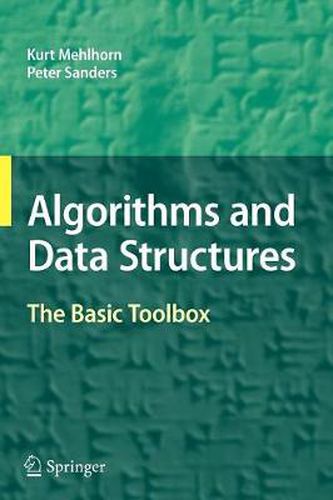Readings Newsletter
Become a Readings Member to make your shopping experience even easier.
Sign in or sign up for free!
You’re not far away from qualifying for FREE standard shipping within Australia
You’ve qualified for FREE standard shipping within Australia
The cart is loading…






This title is printed to order. This book may have been self-published. If so, we cannot guarantee the quality of the content. In the main most books will have gone through the editing process however some may not. We therefore suggest that you be aware of this before ordering this book. If in doubt check either the author or publisher’s details as we are unable to accept any returns unless they are faulty. Please contact us if you have any questions.
Algorithms are at the heart of every nontrivial computer application, and algorithmics is a modern and active area of computer science. Every computer scientist and every professional programmer should know about the basic algorithmic toolbox: structures that allow efficient organization and retrieval of data, frequently used algorithms, and basic techniques for modeling, understanding and solving algorithmic problems.
This book is a concise introduction addressed to students and professionals familiar with programming and basic mathematical language. Individual chapters cover arrays and linked lists, hash tables and associative arrays, sorting and selection, priority queues, sorted sequences, graph representation, graph traversal, shortest paths, minimum spanning trees, and optimization. The algorithms are presented in a modern way, with explicitly formulated invariants, and comment on recent trends such as algorithm engineering, memory hierarchies, algorithm libraries and certifying algorithms. The authors use pictures, words and high-level pseudocode to explain the algorithms, and then they present more detail on efficient implementations using real programming languages like C++ and Java.
The authors have extensive experience teaching these subjects to undergraduates and graduates, and they offer a clear presentation, with examples, pictures, informal explanations, exercises, and some linkage to the real world. Most chapters have the same basic structure: a motivation for the problem, comments on the most important applications, and then simple solutions presented as informally as possible and as formally as necessary. For the more advanced issues, this approach leads to a more mathematical treatment, including some theorems and proofs. Finally, each chapter concludes with a section on further findings, providing views on the state of research, generalizations and advanced solutions.
$9.00 standard shipping within Australia
FREE standard shipping within Australia for orders over $100.00
Express & International shipping calculated at checkout
This title is printed to order. This book may have been self-published. If so, we cannot guarantee the quality of the content. In the main most books will have gone through the editing process however some may not. We therefore suggest that you be aware of this before ordering this book. If in doubt check either the author or publisher’s details as we are unable to accept any returns unless they are faulty. Please contact us if you have any questions.
Algorithms are at the heart of every nontrivial computer application, and algorithmics is a modern and active area of computer science. Every computer scientist and every professional programmer should know about the basic algorithmic toolbox: structures that allow efficient organization and retrieval of data, frequently used algorithms, and basic techniques for modeling, understanding and solving algorithmic problems.
This book is a concise introduction addressed to students and professionals familiar with programming and basic mathematical language. Individual chapters cover arrays and linked lists, hash tables and associative arrays, sorting and selection, priority queues, sorted sequences, graph representation, graph traversal, shortest paths, minimum spanning trees, and optimization. The algorithms are presented in a modern way, with explicitly formulated invariants, and comment on recent trends such as algorithm engineering, memory hierarchies, algorithm libraries and certifying algorithms. The authors use pictures, words and high-level pseudocode to explain the algorithms, and then they present more detail on efficient implementations using real programming languages like C++ and Java.
The authors have extensive experience teaching these subjects to undergraduates and graduates, and they offer a clear presentation, with examples, pictures, informal explanations, exercises, and some linkage to the real world. Most chapters have the same basic structure: a motivation for the problem, comments on the most important applications, and then simple solutions presented as informally as possible and as formally as necessary. For the more advanced issues, this approach leads to a more mathematical treatment, including some theorems and proofs. Finally, each chapter concludes with a section on further findings, providing views on the state of research, generalizations and advanced solutions.